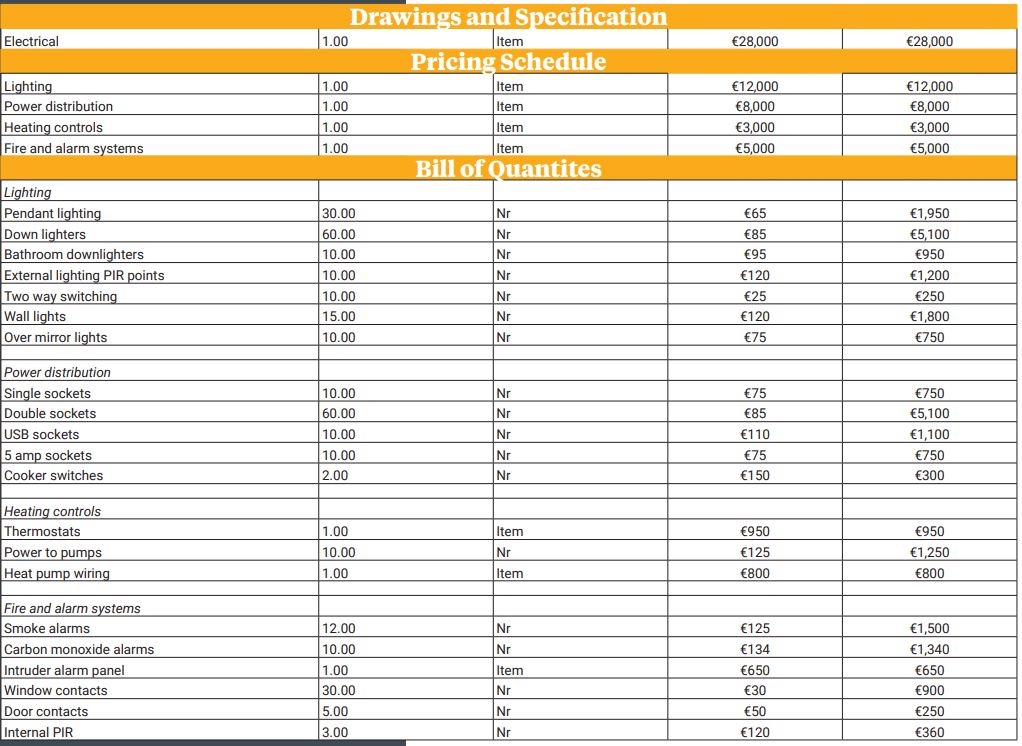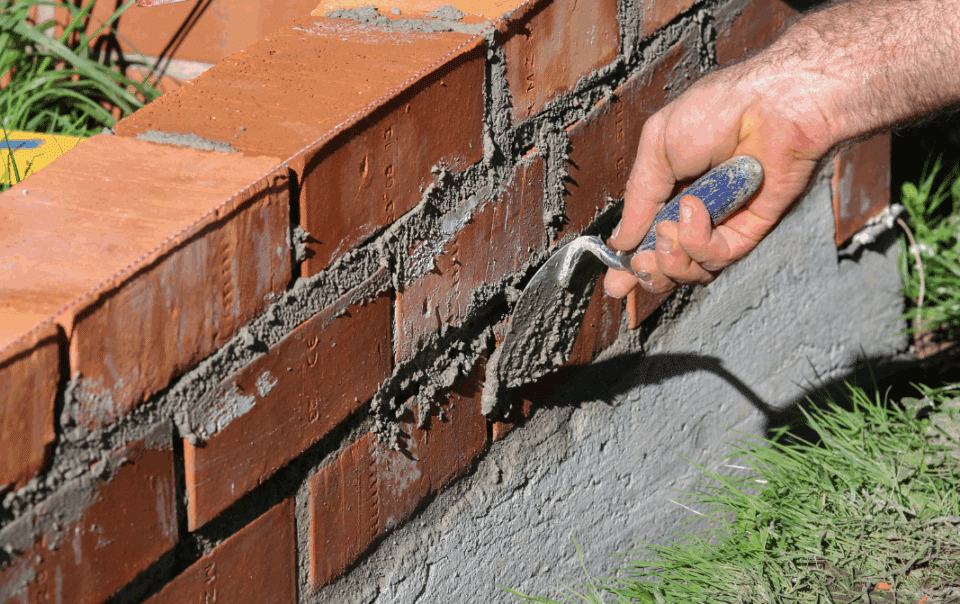[adrotate banner=”59″]
In this article we cover:
- How to get real time build costs
- What is a tender and how they work
- What are PC Sums and how they work
- Example of a pricing schedule
- How to price the entire build
- Choosing a builder out of the tender process
To get a price for your construction drawings with exact specifications (including lighting schedule, heating system, ventilation, etc.) you could get professional help in the form of a Chartered Quantity Surveyor, or estimate how much each of the items will cost yourself, but this will be time consuming and not necessarily accurate.
You could also ask builders to give you a quote on the basis of your plans (direct approach or via tender); they’re likely to give you a price that includes both labour and materials although you could ask them to separate the two. The estimate will either be given with a ‘trade breakdown’ (each trade, e.g. plumber, listed and tasks detailed) or an ‘elemental breakdown’ (every part of the building is itemised, e.g. foundations, walls, etc.). Specialist elements that will see the supplier install the product, like ventilation or heating, will be most accurately costed by the supplier once you send them your drawings.
PC Sums
In reality, few people will have everything chosen at this early stage and it’s true that the price of your skirting boards won’t have a huge impact on the overall budget. However if you leave too many items in the ‘to be determined’ column you can’t expect to get an accurate figure. To get around this, PC (prime cost) sums are often used. It’s a price allocated to items in the ‘to be determined’ column, which often consists of things like the kitchen. This estimate can be given to you by your architect or quantity surveyor or may even be priced by your builder but make sure they’re clear about the quality of finish you have in mind. PC sums are not always accurate and you will have to pay for the difference. You must also be clear about what you really need and what would be nice to have. The ‘wish list’ should be priced separately and only looked at when everything else has come on, or under, budget.
Going to tender Most self-builders who choose to hire a main contractor to oversee all the work on their self-build project will go to tender, unless they are sure of who they will be hiring. A standard tender process consists of:
� Putting together the tender documentation
� Selecting the list of builders you are going to ask to submit a price
� Tender analysis
� Post tender negotiation
� Final selection and contractor appointment with contract
The key to a successful tender is the amount and detail of documentation that you can supply. These are referred to as the tender, or the tender documents which will depend on the type of contact you choose. Tendering should always be very much geared towards having a clear and concise system where everyone prices the same way (comparing apples with apples) so the outcome is unambiguous
and everyone is on a level playing field.

Pricing the build
In NI and ROI the most common two methods of contract are known as the drawings and specification contract and the remeasurable contract.
Drawings and specification alone will leave you with less data to analyse. A remeasurable contract with bill of quantities ensures that nothing is missing, identifies when a contractor has overpriced or more importantly, under priced an item which in many instances could become an issue on site at a later stage.
For a drawings and specification contract, the onus is on the tendering contractor to ensure that the price submitted includes fully for all items necessary. For many therefore, this tender process involves nothing more than issuing drawings to contractors for pricing. This can work perfectly well when the drawings are fully detailed, the items required are fully specified and there is no interpretation possible in respect to what is required.
The difficulty arises when, due to a lack of clarity, two different contractors can see an item in different ways leading to two different interpretations and subsequent prices. This is akin to the old saying of comparing apples with oranges. A further issue can arise from the fact that contractors revert with tender prices in different ways. One contractor may simply supply a single cost to complete all of the work noted on the drawings (I will build your house for x). Another contractor may provide breakdowns for the cost of various high level trades (electrics, plumbing, walls etc) and another contractor may give a greater level of detail.
In a drawings and specification contract, the responsibility for accuracy of any quantities will be a contractor risk item and something they need to check and clarify. If a bill of quantities is supplied by the client in a tender, it is still down to the contractor to check the quantities to ensure they are correct.
When going to tender with a remeasurable contract, you will have both a pricing schedule (or bill of quantities) and the drawings and specification.

A pricing schedule can be a simple list of the various tasks required for the project (foundation, external wall, and so forth) against which tendering contractors insert a price, or it can take the shape of a fully detailed bill of quantities where every single item required is individually measured (concrete to foundation, mesh to foundation, etc.) and listed for the contractor to insert a price.
The benefit of a pricing schedule is that it allows for comparison of prices across a number of headings or items across all of the contractors which will highlight price anomalies that can subsequently be discussed in later negotiating stages.
On a remeasurable contract, the bill of quantities will be a compulsory requirement for the tender, as the bill itself (as opposed to the drawings and specification) will form the basis of the contract between the parties and each item when completed will be remeasured based on the quantities used on site and the rate that was tendered for that item will be used to calculate the end value.
Choosing a builder
A common route to the tender list is to find the names of contractors on site hoardings in the locality. Others will use recommendations, from their designer (or wider design team), friends or family. Or they’ll find the names of builders from magazines, publications, social media or similar advertisements that contractors engage with.
It is standard practice to send your tender to at least five contractors in the local marketplace for a competitive result. It usually takes contractors two to three weeks to put together the tender; make sure the cut off point for receipt of tenders is clear. Depending on your criteria, you’re likely to end up with a shortlist of two or at most three contractors.
Ensure these have references that you can check (never be afraid to knock on the door of a reference by yourself and chat to their previous clients about their experience), ensure they are fully insured and that they are fully tax compliant.

It’s then time to meet the builders to clarify any elements of their tender, ask if they foresee any issues on the project or in the design, ask how long it will take them to complete the project (which can often help in the selection process) and to simply meet the person to see if you can work with them.
Knowing that this will be a relatively long term relationship, for at least a number of months, it is very important that you can see yourself working with the selected contractor. Personality clashes can easily lead to conflicts on site.
Once these meetings take place, and contractors have updated their best and final positions based on any issues raised at the meetings, a contractor is deemed as the preferred contractor. The decision can be based solely on price, it can be based on quality of previous works, it can be based on the duration the contractor is proposing to complete the works or it can be a mixture of these items.
Then the contract is drafted and signed before the parties proceed in their partnership to complete the works, starting with notification to building control.



















